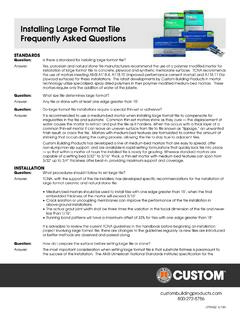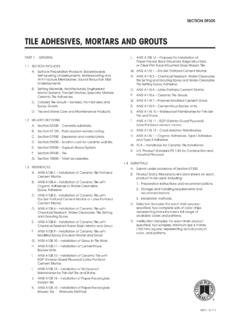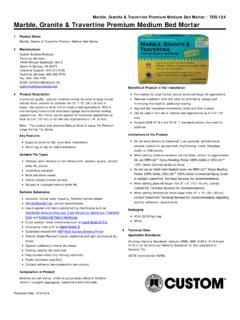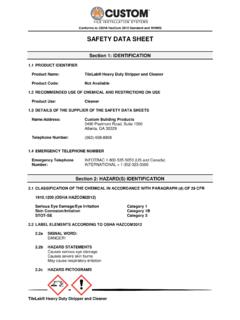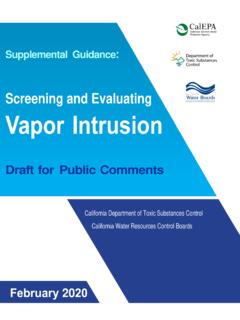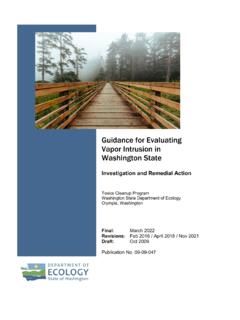Transcription of Subsurface Tolerances and Floor Flatness Requirements — A ...
1 It is common knowledge that putting more effort into surface preparation will yield benefits in your Floor covering installation. Not only will the Floor covering be easier to install, but a truly flat Floor will have an aesthetic quality that building occupants will appreciate. While there are many minimal industry standards for achieving a flat Floor , the question remains: Do they go far enough? As the flooring industry continues to evolve and architects and designers become more demanding construction methods must continue to evolve as , there is a growing demand for larger format ceramic and natural stone tiles.
2 This necessitates proper specification and execution of Floor surface preparation, particularly in relation to Floor Flatness , which is critical to any successful Floor covering installation. To insure a higher quality appearance and reduced life cycle cost, the ceramic tile industry has responded to large format tile trends with updated reference standards and guidelines that provide more specific definitions for large format tile, as well as tighter Tolerances for substrate Flatness . Technical White PaperSELF-LEVELING UNDERLAYMENTSS ubsurface Tolerances and Floor Flatness Requirements A Case for Cementitious Self-Leveling UnderlaymentsBy John D.
3 Gallup, CTC, CSI Architectural Consultatnt Custom Building ProductsAt Custom building Products, we believe substrate Flatness is best achieved through the application of a flowable and cementitious self-leveling underlayment (SLu) and we have developed this paper to address: Potential conditions in the Floor Subsurface and the industry s Requirements related to them Proper specification and installation of a self-leveling underlayment over some common flooring conditions and substrate types the benefits of specifying self-leveling underlayment and cement-based patching and leveling compounds for all hard surface and resilient flooring products the performance and cost efficiencies inherent in using self-leveling underlayment materialsenhAnCed definiTionS foR lARge foRmAT Tile And Subsurface Flatness RequiRemenTSthe American National Standards Institute
4 (ANSI) Specification for the Installation of Ceramic tile stipulates that deviations in sub- Floor Flatness should be no greater than 1/4" in 10' (ref. ANSI / ). before the year 2010, the tile Council of North America (tCNA) described large format tile units as ..generally considered to be 8" x 8" and greater , with no provision for enhanced Subsurface Tolerances when tiles 8" x 8" or larger had been selected. however, as of 2011, Subsurface Tolerances for tile installation, based on tile unit size, have been updated in the tCNA handbook. For tiles with all edges less than 15", the maximum allowable variation is 1/4" in 10' and no more than 1/16" in 12".
5 For large format tiles with one edge greater than 15" and for natural stone tiles, the maximum allowable substrate variation can be no more the 1/8" in 10' and 1/16" in 24". When thin bed epoxy mortars are used, the variation can be no more than 1/16" in 36" with no abrupt irregularities greater than 1/32" (2011 tCNA handbook). In some instances, the architect/designer will require the more stringent finish tolerance, and the Subsurface specification or tile specification should reflect response to the new Subsurface Flatness criteria, a number of tile manufacturers specializing in large format tile materials have embraced these updated Floor Flatness Requirements , and now include references to the new guidelines in their product technical data sheets and installation guidelines.
6 It is the responsibility of the architect or design professional to include these enhanced Floor Flatness Requirements in the project specification. It is equally important for the architect or specifications writer to consult with the design/interiors team (and vice versa) to insure that the specific installation Requirements and guidelines for the selected tile for the project are reflected in the tiling specification. to achieve the required Flatness Tolerances , the industry is increasingly relying on self-leveling underlayments. by virtue of the SLu s working characteristics and performance, a flowable, cementitious self-leveling underlayment will provide Flatness Tolerances well within 1/8" in 10' maximum plane variation.
7 This provides a finished substrate that can accept most ceramic and natural stone tile, including tile that maintains any edge of 15" or greater, as well as all types of resilient flooring. TRAdiTionAl STRAighTedge SPeCifiCATion vS. f-numBeRS foR RATing Floor flATneSSthe American Concrete Institute (ACI) has adopted the so-called f-number system, under the ACI 117 specification, as a way of determining the Flatness (and levelness as per F/L numbers) of concrete slabs. F-numbers are determined through testing procedures in AStM e-1155. these testing procedures are also referenced in AStM F-710 for the Preparation of Concrete Floors to receive resilient Flooring.
8 Determining the Flatness of a concrete slab using the AStM e-1155 method provides more accurate and reliable results compared to the conventional straightedge specification for 1/4" in 10', and 1/8" in 10' plane variation. under AStM e-1155, ACI sets forth guidelines that require specified Floor Flatness be assessed within 72 hours after concrete installation, to insure accuracy. Photo Courtesy AbW Construction Woodinville, WATechnical White PaperSELF-LEVELING UNDERLAYMENTSW here a typical straightedge method for plane variation indicates only where gaps occur between a 10' straightedge and finished Floor , Floor Flatness testing procedures under AStM e-1155 provide a more quantitative method for determining the Flatness and levelness of the entire concrete substrate.
9 While a number of various techniques exist for measuring concrete to determine f-numbers, perhaps the most common is the dipstick Floor profiler method, in which assessments are taken at a frequency of 1 ft., in both north/south and east/west directions. Measurement lines must maintain a minimum of 11 ft., and a minimum of 34 readings per 1000 sq. ft. of Floor is required. the dipstick testing apparatus is broadcast along a line, which measures the variation in surface elevation at 1 ft. intervals. A reading is recorded at a point when the dipstick is pivoted, and the alternate foot of the apparatus is placed on the SPeCifiCATionS ShAll indiCATe The CoRReCTive meASuReS foR ConCReTe SlABS ThAT ARe noT in ComPliAnCe WiTh PRojeCT And CondiTion Requirements .
10 Appropriate Floor Flatness Requirements for the slab, based on conditions, intended usage, and service Requirements , can be found in ACI 302 section - Guide for Concrete Floor and Slab Construction. Although there is no exact method of comparing f-numbers to conventional straightedge testing results, the following chart can be used as a guideline to approximate values between the two:F-Number Result (FF)Straightedge Specification Result (Plane Variation in 10')251/4"501/8"1001/16"F-Number Results of Self-Leveling ApplicationsInstalling a self-leveling underlayment makes it easy to exceed the Requirements of the Floor covering.



